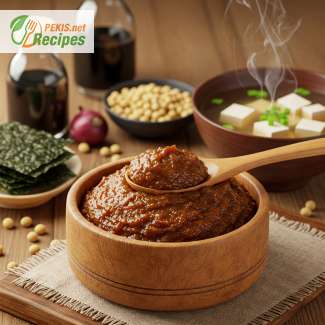
The Essential Guide to Miso Paste: Health Benefits, Culinary Uses, and Recipes
Introduction to Miso Paste
Miso paste is a fermented soybean paste that has been a cornerstone of Japanese cuisine for centuries. Known for its umami-rich flavor, miso adds depth to a variety of dishes, from soups and marinades to dressings and glazes. With a rich nutritional profile, miso is also valued for its potential health benefits, including gut health support and immune system enhancement.
This guide will explore everything you need to know about miso paste, including its origins, nutritional benefits, different types, how to use it in cooking, and recipes to help you incorporate this versatile ingredient into your meals.
The History and Origins of Miso Paste
Miso paste has a long and fascinating history that dates back to ancient China, where a similar fermented soybean product was developed. Over time, Buddhist monks introduced the practice of fermenting soybeans to Japan, where miso evolved into the ingredient we recognize today. By the Heian period (794-1185), miso had become a staple in Japanese households, used both as a seasoning and a nutritional powerhouse.
Throughout history, different regions of Japan have developed their own variations of miso, influenced by local ingredients and climate. Today, miso continues to be an essential part of Japanese cuisine, with growing popularity across the world due to its umami-packed taste and health benefits.
Types of Miso Paste
Miso paste comes in various types, each with its own unique flavor profile and culinary applications. The main types include:
White Miso (Shiro Miso)
- Mild and slightly sweet
- Fermented for a shorter period (few weeks to months)
- Ideal for soups, dressings, and marinades
Red Miso (Aka Miso)
- Stronger, more pungent taste
- Aged for several months to years
- Best suited for hearty soups, stews, and glazes
Yellow Miso (Shinshu Miso)
- Moderate saltiness and umami flavor
- A balanced option for everyday cooking
- Used in soups, stir-fries, and dipping sauces
Barley Miso (Mugi Miso)
- Made with barley and soybeans, offering an earthy flavor
- Commonly used in regional Japanese dishes
Hatcho Miso
- A rich, dark miso with intense umami
- Traditionally made with only soybeans and salt
- Ideal for robust dishes like miso-glazed meats
Each type of miso has a distinct taste and best culinary application, making it a versatile ingredient in various recipes.
Nutritional Benefits of Miso Paste
Miso is packed with essential nutrients, making it a health-promoting food. Some key nutritional benefits include:
Rich in Probiotics
- Supports gut health by promoting beneficial bacteria
- Aids digestion and nutrient absorption
High in Protein
- Complete protein source containing all essential amino acids
- Great for vegetarians and vegans seeking plant-based protein
Packed with Vitamins and Minerals
- Contains B vitamins, Vitamin K, and folate
- A good source of iron, calcium, and magnesium
Potential Health Benefits
- Boosts the immune system with antioxidants and beneficial bacteria
- May support heart health by reducing cholesterol levels
- Contains anti-inflammatory properties
Miso is a nutritional powerhouse, but it's also high in sodium, so it's best consumed in moderation.
How to Use Miso Paste in Cooking
Miso paste is an incredibly versatile ingredient that can enhance the flavor of many dishes. Here are some of the best ways to incorporate miso into your cooking:
Miso Soup
One of the most classic uses, miso soup is a comforting dish made by dissolving miso paste in dashi broth and adding ingredients like tofu, seaweed, and green onions.
Marinades and Glazes
Miso's salty-sweet depth makes it a perfect base for marinades and glazes for proteins like chicken, fish, and tofu.
Salad Dressings
Mixing miso with ingredients like sesame oil, vinegar, and honey creates a delicious, umami-rich dressing.
Stir-Fries and Noodles
A small amount of miso paste can boost the flavor of stir-fried vegetables and noodle dishes.
Sauces and Dips
Combine miso with tahini, garlic, and lemon juice for a flavorful dipping sauce.
Miso is a highly adaptable ingredient, capable of enhancing both traditional and modern recipes.
Delicious Miso-Based Recipes
To help you get started with miso in your kitchen, here are some simple yet delicious recipes:
Classic Miso Soup
Ingredients:
- 4 cups dashi broth
- 2 tbsp white miso paste
- 1/2 cup cubed tofu
- 1 tbsp wakame seaweed
- 2 tbsp chopped green onions
Instructions:
- Heat the dashi broth in a pot over medium heat.
- In a small bowl, dissolve miso paste in a bit of warm water, then add it to the pot.
- Stir in the tofu and wakame and cook for 2-3 minutes.
- Garnish with green onions and serve hot.
Miso-Glazed Salmon
Ingredients:
- 2 tbsp red miso paste
- 1 tbsp soy sauce
- 1 tbsp honey
- 1 tsp grated ginger
- 2 salmon fillets
Instructions:
- Preheat the oven to 375°F (190°C).
- Mix miso, soy sauce, honey, and ginger into a glaze.
- Brush onto salmon fillets and bake for 12-15 minutes.
- Serve with steamed rice and vegetables.
Storing and Preserving Miso Paste
To maintain the quality and freshness of miso paste, follow these storage tips:
- Store in an airtight container in the refrigerator.
- Avoid contamination by using a clean spoon.
- Miso can last for up to a year, but flavors may deepen over time.
Miso paste is a flavorful, nutrient-rich ingredient that offers numerous health benefits and endless culinary possibilities. Whether you're making a classic miso soup, a savory marinade, or a hearty stew, miso brings an umami depth that enhances any dish. By incorporating this versatile fermented food into your diet, you can enjoy both its delicious taste and nutritional advantages.
Start experimenting with miso paste today and elevate your home cooking with its rich, umami-packed goodness!